Karsha Monastery, perched dramatically on a hilltop overlooking the Zanskar Valley, is the region’s largest and most significant monastic complex. Located in Ladakh, this centuries-old monastery is a spiritual and architectural marvel, offering breathtaking views of the surrounding landscape. It houses several ancient shrines, exquisite murals, and a treasured collection of Buddhist relics. The serene atmosphere and the monastery’s rich cultural heritage make it a must-visit for those seeking a deeper understanding of Ladakh’s spiritual traditions. Visitors are often drawn to the peaceful setting and the opportunity to witness traditional Buddhist rituals.
Karsha Monastery Location
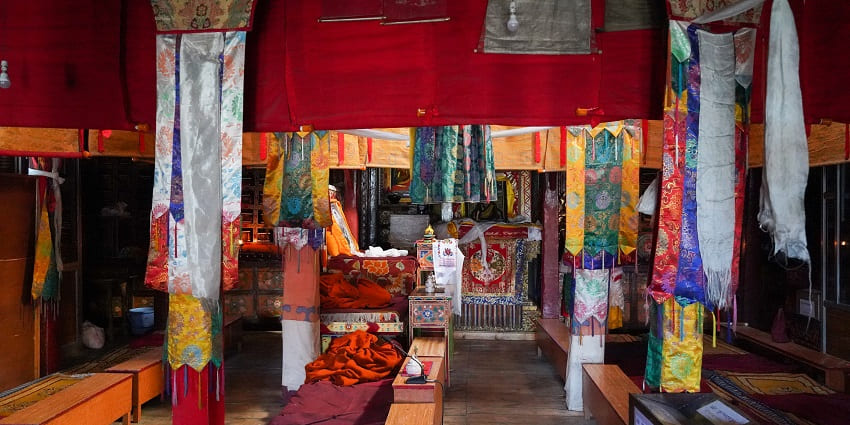
Photo: Timothy A. Gonsalves / Wikimedia Commons
Karsha Monastery is located in the remote Zanskar Valley of Ladakh, Jammu and Kashmir, perched on a steep hilltop overlooking the vast and serene landscape. It lies about 12 kilometres from the town of Padum, the administrative centre of Zanskar, making it accessible via a scenic drive through rugged mountain terrain.
Suggested Read: Places To Visit In Ladakh
How To Reach Karsha Monastery
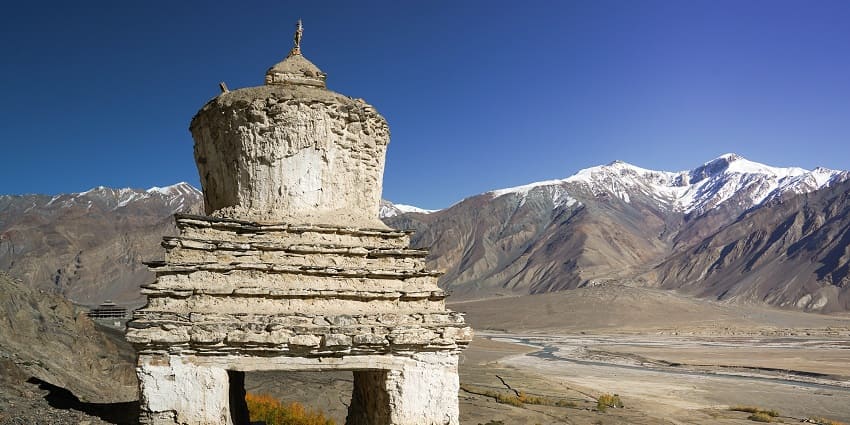
Photo: Timothy A. Gonsalves / Wikimedia Commons
By Air: The nearest airport is in Leh, around 235 km from Karsha. Regular flights connect Leh with cities like Delhi, Mumbai, and Srinagar.
By Road: From Leh, travellers can hire a taxi or take a bus to Padum, the main town in Zanskar Valley. The drive to Padum takes around 12-14 hours on rugged mountain roads.
From Padum: Karsha Monastery is 8 km from Padum. You can hire a local taxi or trek to the monastery, enjoying scenic views along the way.
Places To Visit In And Around Karsha Monastery
Here is the list of nearby places that you can discover on your trip to the majestic Karsha Monastery in Ladakh.
1. Padum Village
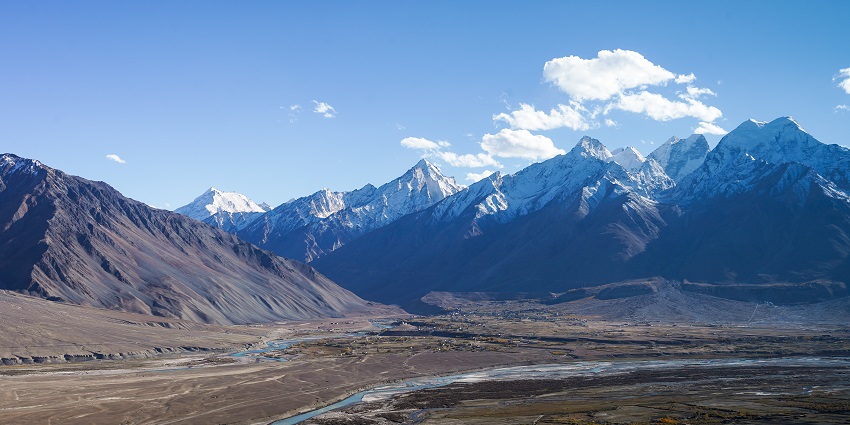
Photo: Timothy A. Gonsalves / Wikimedia Commons
Padum Village, the administrative centre of the Zanskar Valley in Ladakh, serves as a hub for travellers exploring the remote region. Surrounded by majestic mountains and rivers, it is a picturesque village that offers a glimpse into the traditional Ladakhi lifestyle. Padum is a gateway to many famous monasteries, including Karsha and Stongdey, and is a starting point for trekking routes across Zanskar. The village also has a small market, a few guesthouses, and restaurants catering to tourists. Its mix of Buddhist and Muslim cultures and stunning landscapes make Padum a unique destination in the valley.
Timings: 6 AM – 6 PM
Entry Fees: Free
Suggested Read: Top Places To Visit In Kargil To Explore History And Unveil Adventure
2. Sani Monastery
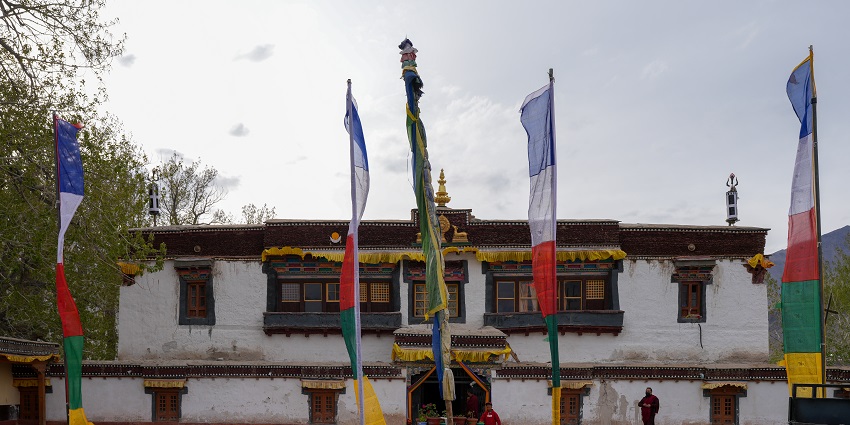
Photo: Timothy A. Gonsalves / Wikimedia Commons
Sani Monastery, one of the oldest and most significant monasteries in the Zanskar region of Ladakh, dates back to the 1st century. Located about 6 km from Padum, it is unique as it combines Buddhism and ancient Bon religion elements. The monastery is part of the Drukpa Kagyu lineage of Tibetan Buddhism and features a large chorten (stupa) and a central prayer hall with ancient murals and relics. Sani Monastery is famous for the annual Naro Nasjal festival, where monks perform Cham dances to honour the revered Buddhist saint Naropa..
Timings: 6 AM – 6 PM
Entry Fees: Free
3. Stongdey Monastery
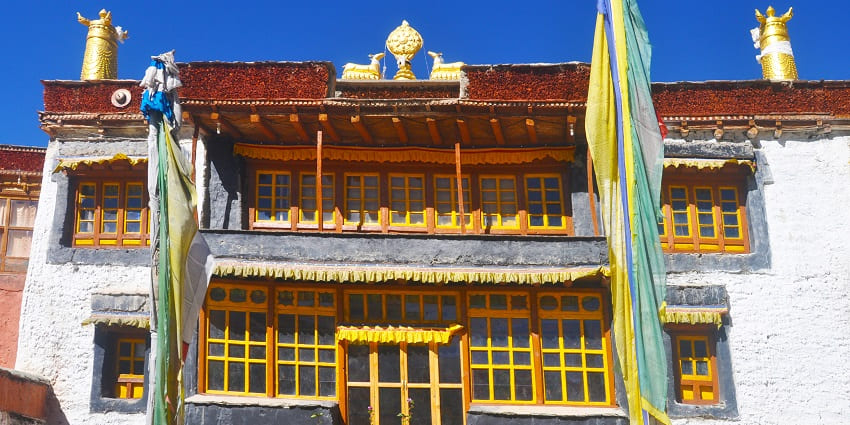
Photo: Prof Ranga Sai / Wikimedia Commons
Stongdey Monastery, located about 18 km north of Padum in the Zanskar region of Ladakh, is the second-largest monastery in the area. Founded in the 11th century by Lama Marpa Lotsawa, a disciple of the famous Indian scholar Naropa, the monastery belongs to the Gelugpa (Yellow Hat) sect of Tibetan Buddhism. Perched on a hilltop, it offers panoramic views of the Zanskar Valley. The monastery complex includes seven temples adorned with beautiful murals and thangkas (Buddhist paintings).
Timings: 6 AM – 6 PM
Entry Fees: Free
Suggested Read: Discover The Famous Monasteries In Ladakh
4. Phuktal Monastery
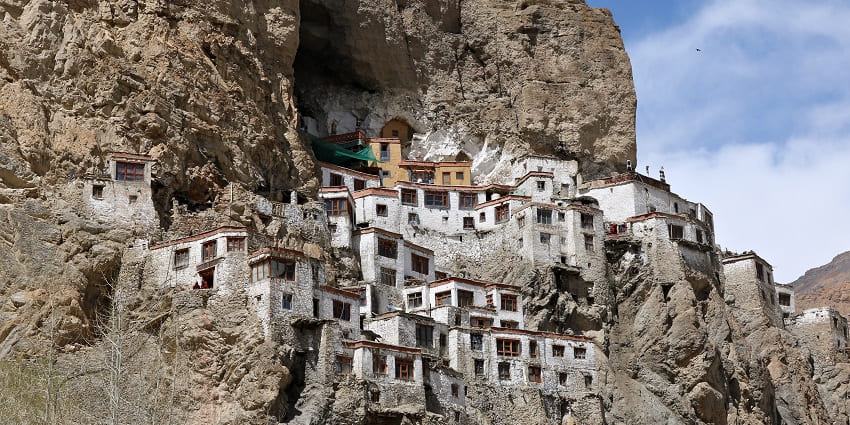
Photo: Ingo Mehling / Wikimedia Commons
Phuktal Monastery, located in the remote Zanskar region of Ladakh, is an extraordinary Buddhist monastery built into a cliffside cave overlooking the Lungnak River. Accessible only by a challenging trek, this ancient site is a spiritual retreat for monks and travellers alike. Founded in the 12th century, it belongs to the Gelugpa sect of Tibetan Buddhism and features stunning murals, prayer halls, and a sacred spring believed to have healing properties. Its unique architecture and serene surroundings make it a perfect destination for those seeking peace, adventure, and a deep connection with Buddhist traditions.
Timings: 7 AM – 6 PM
Entry Fees: Free
5. Zongkhul Monastery
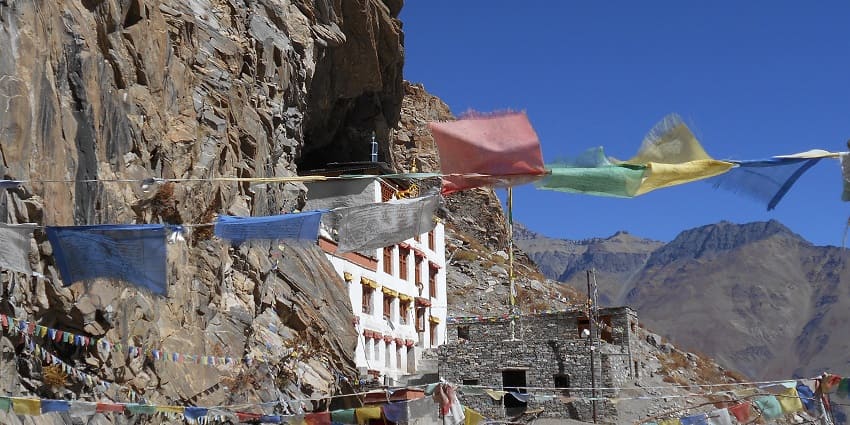
Photo: Prof Ranga Sai / Wikimedia Commons
Zongkhul Monastery, nestled on a cliff in the Zanskar Valley, is a captivating Buddhist site renowned for its serene atmosphere and spiritual significance. This unique cave monastery is believed to have been founded by the Tibetan yogi Naropa during his meditation retreats in the region. The monastery’s location, perched high on the rugged cliffs, offers breathtaking views of the valley below, making it a popular destination for both pilgrims and travellers seeking solitude. Inside, the monastery houses ancient murals, sacred relics, and meditation caves used by monks for centuries.
Suggested Read: Adventure Sports In Ladakh – Planning The Ultimate Trip
Timings: 7 AM – 7 PM
Entry Fees: Free
Where To Stay
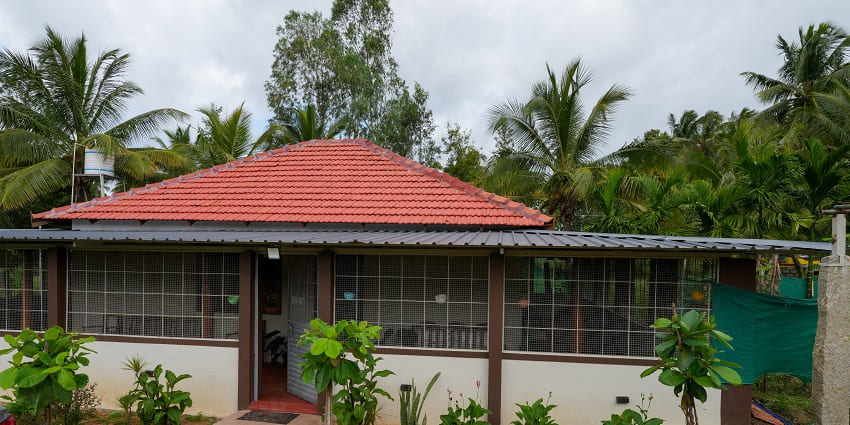
Photo: Timothy A. Gonsalves / Wikimedia Commons / Image For Representation Only
For visitors to Karsha Monastery, staying in Padum Village, about 11 km away, is the best option as it offers several guesthouses and basic accommodations. Popular options include Hotel Ibex and Jangchub Jong Guesthouse, which provide comfortable rooms and local hospitality. These places offer easy access to the monastery and other attractions in Zanskar Valley. Some travellers also opt for homestays in Karsha village itself, where they can experience the traditional Ladakhi lifestyle firsthand.
Where To Eat
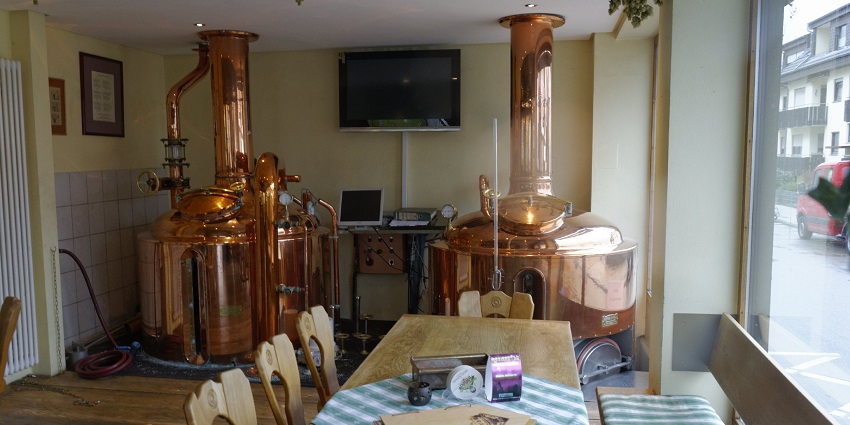
Photo: Ra Boe / Wikimedia Commons / Image For Representation Only
Dining options near Karsha Monastery are limited, but Padum Village, about 11 km away, offers a few local eateries and guesthouses serving simple, home-cooked meals. Hotel Ibex and Jangchub Jong Guesthouse have in-house restaurants offering traditional Ladakhi dishes, as well as Indian and Tibetan food. Small local eateries in Padum also serve thukpa (Tibetan noodle soup), momos (dumplings), and other regional specialities. For a more authentic experience, visitors can opt for homestays in Karsha village, where Ladakhi families often provide traditional meals made with locally sourced ingredients, offering a taste of Zanskar’s culinary culture.
Suggested Read: Trekking In Ladakh Zanskar
Best Time To Visit
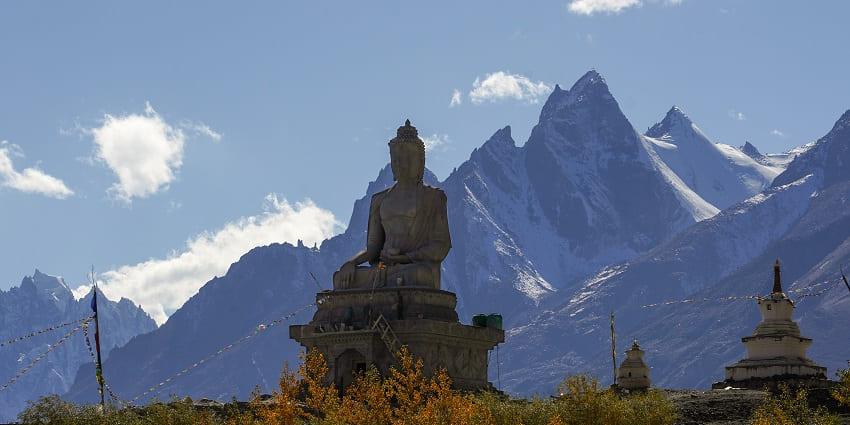
Photo: Timothy A. Gonsalves / Wikimedia Commons / Image For Representation Only
The best time to visit Karsha Monastery is during the summer months from May to September. During this period, the weather in Ladakh is pleasant, with temperatures ranging from 15°C to 25°C, making it ideal for exploring the region’s stunning landscapes and rich cultural heritage. The roads are fully accessible, allowing travellers to reach the monastery and surrounding areas without difficulty.\
Other Factors To Consider
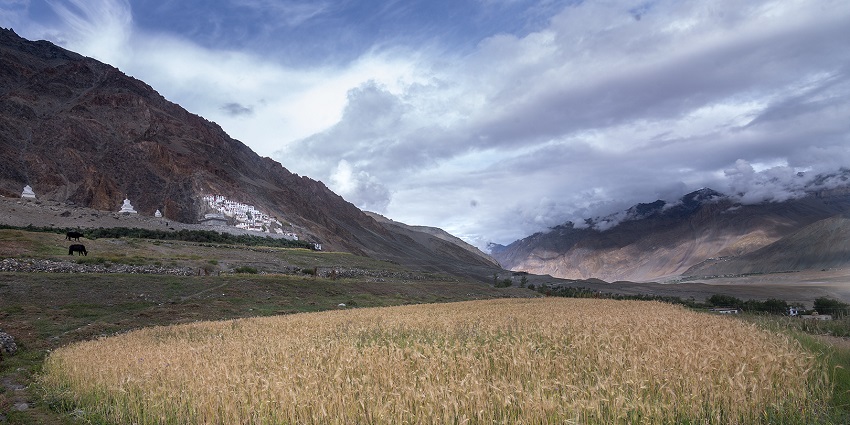
Photo: Darshan Ganapathy / Wikimedia Commons / Image For Representation Only
Altitude Adjustment: Karsha is located at a high altitude, so allow time to acclimatize in Leh before heading to the monastery to prevent altitude sickness.
Local Customs: Respect local customs and dress modestly when visiting the monastery, as it is a sacred site.
Travel Insurance: Consider purchasing travel insurance that covers high-altitude trekking and any unforeseen circumstances.
Transportation Availability: Confirm transportation options in advance, as public transport can be limited, and hiring a local taxi or arranging transfers is often necessary.
Suggested Read: Enhance Your Vacation With These Things To Do In Ladakh
Visiting Karsha Monastery offers a unique opportunity to immerse yourself in the rich spiritual heritage and stunning natural beauty of Ladakh. From its serene ambience and breathtaking views of the Zanskar Valley to the chance to witness traditional Buddhist rituals, this monastery is a treasure trove of culture and history. Whether you’re an avid trekker or a spiritual seeker, Karsha promises an unforgettable experience. Plan your trip with TripXl and be sure to have an amazing experience.
Cover Photo: Timothy A. Gonsalves / Wikimedia Commons


 WhatsApp
WhatsApp
 Twitter
Twitter









